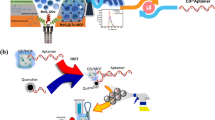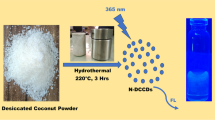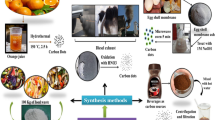Abstract
Water-soluble Cu nanoclusters (NCs) with tunable emission were synthesized through an eco-friendly one-pot aqueous method. Blue-, green-, and red-emitting NCs with the emission peaks at 420 nm, 505 nm, and 630 nm were obtained by employing ethanediamine, cysteine, and glutathione as surface ligands, respectively. The ligand effects on the optical properties of Cu NCs were studied by the single variable method. It has been revealed by systematic characterizations that the dependence of emission color on the structures of ligands was mainly attributed to their different size-tuning effects. Glutathione has the strongest chelating ability and it can significantly reduce the monomer reactivity and thus decrease the supersaturation degree of the reaction, which is favorable for modulating Cu precursor to grow into larger NCs. In contrast, ethanediamine ligand resulted in smaller nanoclusters due to its weaker binding capability. Because of the strong emission and terrific fluorescent stability, Cu NCs capped with ethanediamine, possessing an emission peak at 420 nm when excited at a wavelength of 350 nm, were directly used for probing Hg(II) with satisfying selectivity, presenting a linear range of 0.1–5.0 mM and a detection limit of 33 μM. The sensor showed good performance in real sample analysis with recoveries ranging from 99% to 103%, and comparable accuracy with atomic fluorescence spectroscopy, manifesting the reliability of the current strategy for sensing Hg(II).

Water-soluble copper nanoclusters with blue, green, and red emissions were synthesized by employing ethanediamine, cysteine, and glutathione as surface ligands respectively, and the blue-emitting nanoclusters with strong emission and terrific stability were directly used for selectively sensing Hg2+.






Similar content being viewed by others
References
Han A, Xiong L, Hao S, Yang Y, Li X, Fang G, Liu J, Pei Y, Wang S (2018) Highly bright self-assembled copper nanoclusters: a novel Photoluminescent probe for sensitive detection of histamine. Anal Chem 90:9060–9067
Ye M, Yu Y, Lin B, Cai Y, Cao Y, Guo M, Zhu D (2019) Copper nanoclusters reversible switches based on ions-triggered for detection of inorganic pyrophosphatase activity. Sensors Actuators B Chem 284:36–44
Wang Z, Chen B, Rogach AL (2017) Synthesis, optical properties and applications of light-emitting copper nanoclusters. Nanoscale Horiz 2:135–146
Hu X, Liu T, Zhuang Y, Wang W, Li Y, Fan W, Huang Y (2016) Recent advances in the analytical applications of copper nanoclusters. TrAC Trend Anal Chem 77:66–75
Zhang L, Wang E (2014) Metal nanoclusters: new fluorescent probes for sensors and bioimaging. Nano Today 9:132–157
Zhou T, Zhu J, Gong L, Nong L, Liu J (2019) Amphiphilic block copolymer-guided in situ fabrication of stable and highly controlled luminescent copper Nanoassemblies. J Am Chem Soc 141:2852–2856
Wang Z, Y-e S, Yang X, Xiong Y, Li Y, Chen B, Lai W-F, Rogach AL (2018) Water-soluble biocompatible copolymer hypromellose grafted chitosan able to load exogenous agents and copper nanoclusters with aggregation-induced emission. Adv Funct Mater 28:1802848
Hu X, Liu X, Zhang X, Chai H, Huang Y (2018) One-pot synthesis of the CuNCs/ZIF-8 nanocomposites for sensitively detecting H2O2 and screening of oxidase activity. Biosens Bioelectron 105:65–70
Liu Y, Yao D, Zhang H (2018) Self-assembly driven aggregation-induced emission of copper nanoclusters: a novel technology for lighting. ACS Appl Mater Interfaces 10:12071–12080
Wang Z, Zhang CC, Gao J, Wang Q (2017) Copper clusters-based luminescence assay for tetracycline and cellular imaging studies. J Lumin 190:115–122
Lin L, Hu Y, Zhang L, Huang Y, Zhao S (2017) Photoluminescence light-up detection of zinc ion and imaging in living cells based on the aggregation induced emission enhancement of glutathione-capped copper nanoclusters. Biosens Bioelectron 94:523–529
Zhao M, Chen A-Y, Huang D, Zhuo Y, Chai Y-Q, Yuan R (2016) Cu nanoclusters: novel electrochemiluminescence emitters for bioanalysis. Anal Chem 88:11527–11532
Wu Z, Liu J, Gao Y, Liu H, Li T, Zou H, Wang Z, Zhang K, Wang Y, Zhang H, Yang B (2015) Assembly-induced enhancement of Cu nanoclusters luminescence with mechanochromic property. J Am Chem Soc 137:12906–12913
Huang Y, Liu W, Feng H, Ye Y, Tang C, Ao H, Zhao M, Chen G, Chen J, Qian Z (2016) Luminescent nanoswitch based on organic-phase copper nanoclusters for sensitive detection of trace amount of water in organic solvents. Anal Chem 88:7429–7434
Qing T, Zhang K, Qing Z, Wang X, Long C, Zhang P, Hu H, Feng B (2019) Recent progress in copper nanocluster-based fluorescent probing: a review. Microchim Acta 186:670
Tang Q, Yang T, Huang Y (2015) Copper nanocluster-based fluorescent probe for hypochlorite. Microchim Acta 182:2337–2343
Liu G, Shao Y, Peng J, Dai W, Liu L, Xu S, Wu F, Wu X (2013) Highly thymine-dependent formation of fluorescent copper nanoparticles templated by ss-DNA. Nanotechnology 24:345502
Qing Z, He X, He D, Wang K, Xu F, Qing T, Yang X (2013) Poly(thymine)-templated selective formation of fluorescent copper nanoparticles. Angew Chem Int Edit 52:9719–9722
Jia X, Yang X, Li J, Li D, Wang E (2014) Stable Cu nanoclusters: from an aggregation-induced emission mechanism to biosensing and catalytic applications. Chem Commun 50:237–239
Lin Y-J, Chen P-C, Yuan Z, Ma J-Y, Chang H-T (2015) The isomeric effect of mercaptobenzoic acids on the preparation and fluorescence properties of copper nanoclusters. Chem Commun 51:11983–11986
Miao H, Zhong D, Zhou Z, Yang X (2015) Papain-templated Cu nanoclusters: assaying and exhibiting dramatic antibacterial activity cooperating with H2O2. Nanoscale 7:19066–19072
Borghei Y-S, Hosseini M, Ganjali MR, Hosseinkhani S (2017) Label-free fluorescent detection of microRNA-155 based on synthesis of hairpin DNA-templated copper nanoclusters by etching (top-down approach). Sensors Actuators B Chem 248:133–139
Wang Z, Chen B, Susha AS, Wang W, Reckmeier CJ, Chen R, Zhong H, Rogach AL (2016) All-copper nanocluster based down-conversion white light-emitting devices. Adv Sci 3:1600182
Yang X, Feng Y, Zhu S, Luo Y, Zhuo Y, Dou Y (2014) One-step synthesis and applications of fluorescent Cu nanoclusters stabilized by l-cysteine in aqueous solution. Anal Chim Acta 847:49–54
Li D, Wang G, Peng Y, Chen Z, Gao X, Cheng L, Mei X (2019) Development of ratiometric sensing and white light-harvesting materials based on all-copper nanoclusters. Nanoscale Adv 1:1086–1095
Zhao M, Qian Z, Zhong M, Chen Z, Ao H, Feng H (2017) Fabrication of stable and luminescent copper nanocluster-based AIE particles and their application in β-galactosidase activity assay. ACS Appl Mater Interfaces 9:32887–32895
Ai L, Jiang W, Liu Z, Liu J, Gao Y, Zou H, Wu Z, Wang Z, Liu Y, Zhang H, Yang B (2017) Engineering a red emission of copper nanocluster self-assembly architectures by employing aromatic thiols as capping ligands. Nanoscale 9:12618–12627
Das NK, Ghosh S, Priya A, Datta S, Mukherjee S (2015) Luminescent copper nanoclusters as a specific cell-imaging probe and a selective metal ion sensor. J Phys Chem C 119:24657–24664
Li J, Zhu J-J, Xu K (2014) Fluorescent metal nanoclusters: from synthesis to applications. TrAC Trend Anal Chem 58:90–98
Luo Z, Yuan X, Yu Y, Zhang Q, Leong DT, Lee JY, Xie J (2012) From aggregation-induced emission of Au(I)–thiolate complexes to ultrabright Au(0)@Au(I)–thiolate core–shell nanoclusters. J Am Chem Soc 134:16662–16670
Wang L, Miao H, Zhong D, Yang X (2016) Synthesis of dopamine-mediated Cu nanoclusters for sensing and fluorescent coding. Anal Methods 8:40–44
Jiao M, Jing L, Wei X, Liu C, Luo X, Gao M (2017) The Yin and Yang of coordinating co-solvents in the size-tuning of Fe3O4 nanocrystals through flow synthesis. Nanoscale 9:18609–18612
Xu S, Li W, Zhao X, Wu T, Cui Y, Fan X, Wang W, Luo X (2019) Ultrahighly efficient and stable fluorescent gold nanoclusters coated with screened peptides of unique sequences for effective protein and serum discrimination. Anal Chem 91:13947–13952
Jiao M, Li Y, Jia Y, Yang Z, Luo X (2019) Aqueously synthesized color-tunable quaternary Cu-In-Zn-S quantum dots for Cu(II) detection via mild and rapid cation exchange. Sensors Actuators B Chem 294:32–39
Wang Y, Cui M, Jiao M, Luo X (2018) Antifouling and ultrasensitive biosensing interface based on self-assembled peptide and aptamer on macroporous gold for electrochemical detection of immunoglobulin E in serum. Anal Bioanal Chem 410:5871–5878
Jiao M, Huang X, Ma L, Li Y, Zhang P, Wei X, Jing L, Luo X, Rogach A, Gao M (2019) Biocompatible off-stoichiometric copper indium sulfide quantum dots with tunable near-infrared emission via aqueous based synthesis. Chem Commun 55:15053–15056
Jiao M, Jing L, Liu C, Hou Y, Huang J, Wei X, Gao M (2016) Differently sized magnetic/upconversion luminescent NaGdF4:Yb,Er nanocrystals: flow synthesis and solvent effects. Chem Commun 52:5872–5875
Hu X, Wang W, Huang Y (2016) Copper nanocluster-based fluorescent probe for sensitive and selective detection of Hg2+ in water and food stuff. Talanta 154:409–415
Suo Z, Hou X, Hu Z, Liu Y, Xing F, Feng L (2019) Fibrinogen-templated gold nanoclusters for fluorometric determination of cysteine and mercury(II). Microchim Acta 186:799
Ru F, Du P, Lu X (2020) Efficient ratiometric fluorescence probe utilizing silicon particles/gold nanoclusters nanohybrid for “on-off-on” bifunctional detection and cellular imaging of mercury (II) ions and cysteine. Anal Chim Acta 1105:139–146
Liu R, Zuo L, Huang XR, Liu SM, Yang GY, Li SY, Lv CY (2019) Colorimetric determination of lead(II) or mercury(II) based on target induced switching of the enzyme-like activity of metallothionein-stabilized copper nanoclusters. Microchim Acta 186:250
Mao A, Wei C (2019) Cytosine-rich ssDNA-templated fluorescent silver and copper/silver nanoclusters: optical properties and sensitive detection for mercury(II). Microchim Acta 186:541
Lin SM, Geng S, Li N, Li NB, Luo HQ (2016) D-penicillamine-templated copper nanoparticles via ascorbic acid reduction as a mercury ion sensor. Talanta 151:106–113
Dean JA (1999) Lange’s handbook of chemistry, 15th edn. McGraw-Hill, New York
Acknowledgments
The authors would like to acknowledge the financial support from the Natural Science Foundation of China (NSFC, 21802083, 21974075) and the Taishan Scholar Program of Shandong Province of China (ts20110829).
Author information
Authors and Affiliations
Corresponding authors
Ethics declarations
Conflict of interest
The authors declare that they have no competing interests.
Additional information
Publisher’s note
Springer Nature remains neutral with regard to jurisdictional claims in published maps and institutional affiliations.
Electronic supplementary material
ESM 1
(DOCX 5816 kb).
Rights and permissions
About this article
Cite this article
Jiao, M., Li, Y., Jia, Y. et al. Ligand-modulated aqueous synthesis of color-tunable copper nanoclusters for the photoluminescent assay of Hg(II). Microchim Acta 187, 545 (2020). https://doi.org/10.1007/s00604-020-04539-6
Received:
Accepted:
Published:
DOI: https://doi.org/10.1007/s00604-020-04539-6




